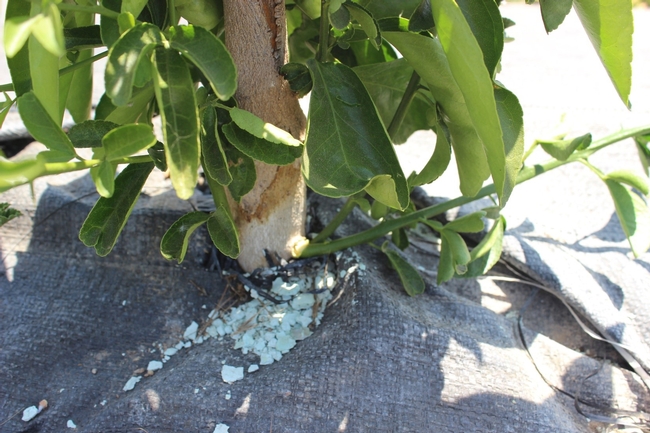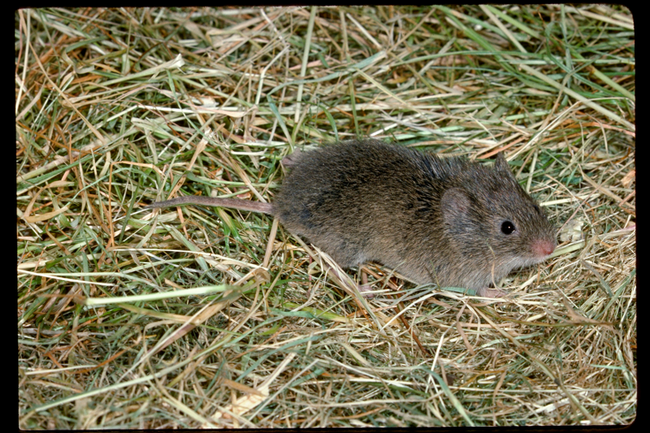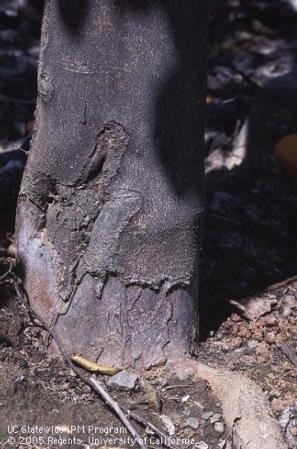- Author: Ben Faber
Along the mighty Santa Clara River are planted many lemons and once upon a time many Valencia orange trees. There's lots of wild life along the river which causes some issues with food safety. One of the many creatures are rats and when things dry up they start foraging further and further for food. They really like citrus and can cause a lot of damage. What I first thought was sun burn damage turned out to be rat feeding on the bark and cambium of these lemon trees. The damage wasn't in the right position to be sunburn damage. Inside the canopy, often on the north facing branch.

- Author: Tunyalee Martin and Chris Laning
UC Statewide IPM Program
Identifying nontarget crop and ornamental plant damage from herbicides has become much easier with the launch of a new online photo repository by the Statewide IPM Program, University of California Division of Agriculture and Natural Resources.
Herbicides applied to manage weeds may move from the site where it was applied in the air or by attaching to soil particles and traveling as herbicide-contaminated soil. When an herbicide contacts a nontarget plant, a plant it was not intended to contact, it can cause slight to serious injury. Herbicide injury also occurs when the sprayer is not properly cleaned after a previous herbicide application. Herbicide residue can be found in the spray tank, spray lines, pumps, filters and nozzles so a sprayer must be thoroughly cleaned after an application. Dry herbicide particles can be redissolved months later and cause herbicide damage to plants. Economic damage includes reduced yield, poor fruit quality, distorted ornamental or nursery plants, and occasionally plant death.
Accurately diagnosing plants that may have herbicide injuries is difficult. In many cases, herbicide symptoms look very similar to symptoms caused by diseases, nutrient deficiencies, environmental stress and soil compaction. Plant disease symptoms such as mottled foliage, brown spots or stem death and plant pests such as insects or nematodes cause foliage to yellow and reduce plant growth similar to herbicide injury.
Dr. Kassim Al-Khatib, weed science professor at UC Davis and director of the UC Statewide Integrated Pest Management Program (UC IPM), has gathered nearly a thousand photos of herbicide-damaged plants, drawn from his own and others' research. The images are cataloged to show damage that can occur from 81 herbicides in more than 14 specific herbicide modes of action, applied in the field to demonstrate the symptoms or when known herbicide spray has drifted onto the plant.
Each image is characterized with the name of the plant, mode of action of the herbicide, and notes the specific symptoms of damage. Together these photos provide a comprehensive archive of damage to over 120 different crops and ornamental plants by known herbicides, which users can easily compare with what they see in the field.
Also included in the repository is information about the modes of action of various herbicides and an index of example herbicide trade names and active ingredients. Users can learn how unintended injury from herbicide occurs from misapplication and carryover from previous crops in addition to drift and herbicide-contaminated tanks.
The repository can be found at http://herbicidesymptoms.ipm.ucanr.edu. Increased knowledge about what causes herbicide damage and how it occurs can lead to fewer cases of herbicide injury occurring through drift or herbicide-contaminated tanks. Using the repository can increase the skill to correctly identify plant damage. Correctly identifying damage as herbicide injury and not from a plant pest or nutrient deficiency can prevent unnecessary applications of pesticides or fertilizers. Fewer applications can lessen the risk of harm of pesticides and fertilizers to people and the environment.

- Author: Neil O'Connell
Since the first publication of this article on vole damage in citrus, a recent field observation regarding vole activity is worth noting. Voles prefer a situation where there is cover and shelter generally from weed or grass. In some orchards established in the last few years a plastic strip has been installed along the tree row for weed management (Fig 1). These strips appear to be offering a sheltered environment for vole activity in some cases (Fig 2). Recent observations in two such installations, one a block planted in 2013 and the other an eight year old planting exhibited significant vole activity. The young orchard at this point does not exhibit obvious tree damage although active tunneling is apparent (Fig 3). In the older orchard feeding damage to the trunks is very obvious (Fig 4).
Meadow Mice (Voles) can cause serious damage in a citrus orchard resulting in partial or complete girdling of a tree (Fig 5). Trees often exhibit damage to the bark of the tree from the soil line up 6-8 inches (Fig. 6 ). On close inspection, an open hole 1-1.5 inches in diameter may be found at the base of the tree (Fig 7).
Five species belonging to the genus Microtus are found in California, two of which “Microtus californicus” and “M.montanus” are reported to cause damage. Damage has been reported in permanent pasture, alfalfa, hay, artichokes, Brussels sprouts, carrots, cauliflower, potatoes, sugar beets, tomatoes, grains, nursery stock and the bark of apple, avocado, citrus, cherry and olive trees.
Microtus are often found where there is grass cover. They generally do not invade cultivated crops until the crop is tall enough to provide food and shelter. Meadow mice are active all year round. They forage at any time during the day or night but are chiefly nocturnal. They are usually found in colonies marked by numerous 2-- inch wide surface runways though matted grass. Small brownish fecal pellets and short pieces of grass stems along the runways are evidence of activity. The burrows consist of extensive underground tunnels, nest chambers and storage chambers. Home range is typically small, less than a 60 foot radius in the case of “M.californicus”. All meadow mice swim well. Therefore, irrigation ditches will not serve as effective barriers against meadow mice movement into fields. Meadow mice may forage beyond the sheltered runways. Food consists of tubers, roots, seeds, grain, and succulent stems and leaves.
Females breed at 4 to 6 weeks of age with litter size of “M.californicus” averaging around 4. Under natural conditions a female Microtus may produce from 5 to 10 litters a year. The major breeding season corresponds with the season of forage growth. Microtus populations build up to a peak every 3 to 4 years, followed by a rapid decline during the next breeding season. The exact causes of the cycle of buildup and decline are not known, though disease, food shortages, physiological stress from overcrowding, and other factors may be involved. It is assumed that in cultivated areas Microtus populations are permanently based in favorable habitat such as roadsides, canal banks or adjacent noncultivated land. Invasion of cultivated cropland occurs when the population builds up or when the wild habitat becomes unfavorable. Coyotes, badgers, weasels, snakes, hawks, owls, herons and gulls are among the principal predators. It is believed that predators are not able to prevent or control a population eruption because of the birth rate of the fast breeding Microtus population. Meadow mice are classified as nongame mammals by the California Fish and Game Code. Nongame mammals, which are found to be injuring growing crops may be taken at any time or in any manner by the owner/management. The most effective management options in an orchard situation are a reduction in ground cover and the use of toxic baits. Meadow mice are cover dependent. In situations where cover removal is not possible or is insufficient to solve the problem, the next best option is the use of toxic baits. Many bait carriers are used (e.g., oat groats, wheat bait). Baits: Crimped oat groats are the most satisfactory bait although crimped whole oats are used (e.g., oat groats, wheat grains, pelletized formulations, etc., but crimped oat groats have typically been most effective). The primary toxicants used for meadow mouse control include zinc phosphide, diphacinone, and chlorophacinone. Directions for management including baiting can be obtained by contacting the Agricultural Commissioner's Office. * Portions taken from J.P.Clark Vertebrate Pest Control







- Author: Ben Faber
In a mandarin orchard today, I saw what appeared to be sun burn damage. The bark was missing on the top, south facing branches. It was old damage and was healing over along the edges. I mentioned it to the grower who told me it was roof rat damage. Several years prior when we had had a long dry winter, the rats had come out of the hills and were eating his fruit, as well as feeding on the cambium. I've seen this damage in trees near the edges of wild country, as well as along stream and river beds. At one orchard in Santa Paula, the feeding had actually spread Phytophthora in the canopy of lemon trees. For control measures go to:
http://www.ipm.ucdavis.edu/PMG/r107600711.html

Evaluating Damage to Baby Trees Requires Patience
Earlier temperatures and forecasted temperatures do not appear to be cold enough to freeze baby trees in the citrus belt. Time will tell. Semi-dormant wood in the winter looks dry even when it is healthy, so any final evaluation should be conducted in the warmth of spring. With warmer temperatures, frozen bark will peel easily from the young trunk and the degree of damage easily estimated. A tree, even those frozen down to the top of the wrap, can make an amazing recovery. Growers, in the summer after the 1990 freeze had some success budding onto the rootstocks that remained after the scions were killed by frost.
It may be better to replace a tree if it is still alive under the trunk wrap but badly damaged. Badly frozen trees regrow fairly slowly, and often are not able to resist pathogens that grow into the wood such as fungal Fusarium species causing dry root rot. Slow growing Fusarium in the wood can take up to 10 or 15 years to kill a tree.
Badly Frozen Young Trees
Badly frozen fruit may start dropping from the tree shortly after the freeze, but other fruit may hang on the tree longer than unfrozen fruit. Many growers resist picking or dropping frozen fruit in that it is another expense, at a time of little income. Reasons for dropping the fruit, even if it cannot be sold for juice, include:
Ensuring that the frozen fruit does not interfere with spring fruit set. Navel oranges, for example, will not set as much fruit if last season’s fruit remains on the tree.
Old frost-damaged fruit may harbor fungal pathogens that may infect the new crop, such as clear rot (Penicillium sp.), tear staining (Colletotrichum sp), brown rot (Phytophthora sps.) or Septoria organisms.
Avoiding having to separate last year’s partially frozen fruit from the new crop at harvest next year.
Preventing partially frozen fruit from providing habitat for insect pests.




